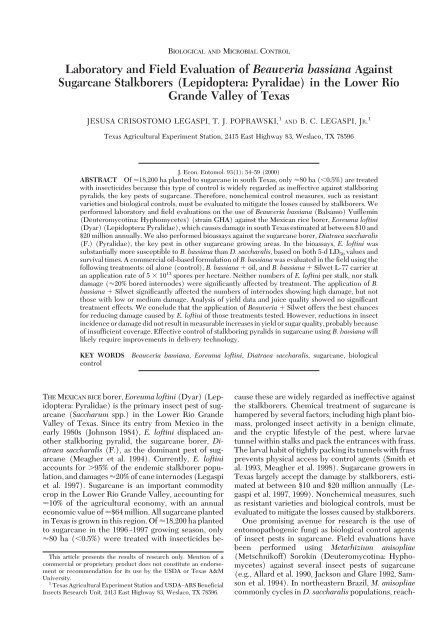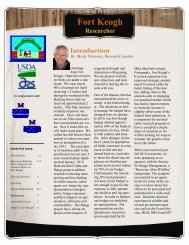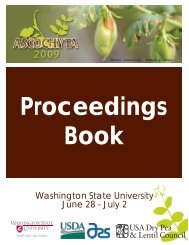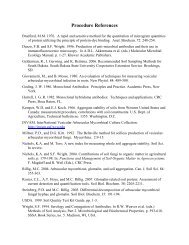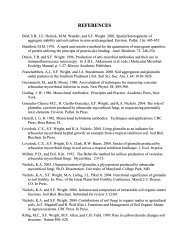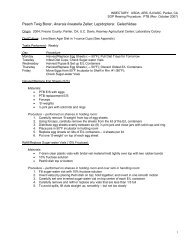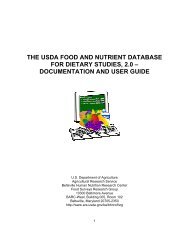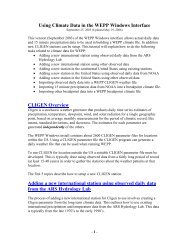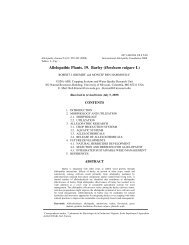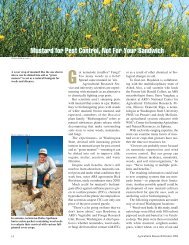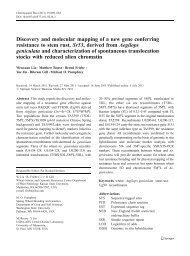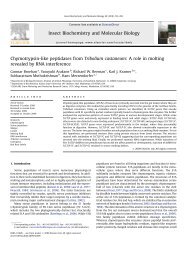Laboratory and Field Evaluation of Beauveria bassiana ... - BioOne
Laboratory and Field Evaluation of Beauveria bassiana ... - BioOne
Laboratory and Field Evaluation of Beauveria bassiana ... - BioOne
You also want an ePaper? Increase the reach of your titles
YUMPU automatically turns print PDFs into web optimized ePapers that Google loves.
BIOLOGICAL AND MICROBIAL CONTROL<br />
<strong>Laboratory</strong> <strong>and</strong> <strong>Field</strong> <strong>Evaluation</strong> <strong>of</strong> <strong>Beauveria</strong> <strong>bassiana</strong> Against<br />
Sugarcane Stalkborers (Lepidoptera: Pyralidae) in the Lower Rio<br />
Gr<strong>and</strong>e Valley <strong>of</strong> Texas<br />
JESUSA CRISOSTOMO LEGASPI, T. J. POPRAWSKI, 1 AND B. C. LEGASPI, JR. 1<br />
Texas Agricultural Experiment Station, 2415 East Highway 83, Weslaco, TX 78596<br />
J. Econ. Entomol. 93(1): 54Ð59 (2000)<br />
ABSTRACT Of 18,200 ha planted to sugarcane in south Texas, only 80 ha (0.5%) are treated<br />
with insecticides because this type <strong>of</strong> control is widely regarded as ineffective against stalkboring<br />
pyralids, the key pests <strong>of</strong> sugarcane. Therefore, nonchemical control measures, such as resistant<br />
varieties <strong>and</strong> biological controls, must be evaluated to mitigate the losses caused by stalkborers. We<br />
performed laboratory <strong>and</strong> Þeld evaluations on the use <strong>of</strong> <strong>Beauveria</strong> <strong>bassiana</strong> (Balsamo) Vuillemin<br />
(Deuteromycotina: Hyphomycetes) (strain GHA) against the Mexican rice borer, Eoreuma l<strong>of</strong>tini<br />
(Dyar) (Lepidoptera: Pyralidae), which causes damage in south Texas estimated at between $10 <strong>and</strong><br />
$20 million annually. We also performed bioassays against the sugarcane borer, Diatraea saccharalis<br />
(F.) (Pyralidae), the key pest in other sugarcane growing areas. In the bioassays, E. l<strong>of</strong>tini was<br />
substantially more susceptible to B. <strong>bassiana</strong> than D. saccharalis, based on both 5-d LD 50 values <strong>and</strong><br />
survival times. A commercial oil-based formulation <strong>of</strong> B. <strong>bassiana</strong> was evaluated in the Þeld using the<br />
following treatments: oil alone (control), B. <strong>bassiana</strong> oil, <strong>and</strong> B. <strong>bassiana</strong> Silwet L-77 carrier at<br />
an application rate <strong>of</strong> 5 10 13 spores per hectare. Neither numbers <strong>of</strong> E. l<strong>of</strong>tini per stalk, nor stalk<br />
damage (20% bored internodes) were signiÞcantly affected by treatment. The application <strong>of</strong> B.<br />
<strong>bassiana</strong> Silwet signiÞcantly affected the numbers <strong>of</strong> internodes showing high damage, but not<br />
those with low or medium damage. Analysis <strong>of</strong> yield data <strong>and</strong> juice quality showed no signiÞcant<br />
treatment effects. We conclude that the application <strong>of</strong> <strong>Beauveria</strong> Silwet <strong>of</strong>fers the best chances<br />
for reducing damage caused by E. l<strong>of</strong>tini <strong>of</strong> those treatments tested. However, reductions in insect<br />
incidence or damage did not result in measurable increases in yield or sugar quality, probably because<br />
<strong>of</strong> insufÞcient coverage. Effective control <strong>of</strong> stalkboring pyralids in sugarcane using B. <strong>bassiana</strong> will<br />
likely require improvements in delivery technology.<br />
KEY WORDS <strong>Beauveria</strong> <strong>bassiana</strong>, Eoreuma l<strong>of</strong>tini, Diatraea saccharalis, sugarcane, biological<br />
control<br />
THE MEXICAN RICE borer, Eoreuma l<strong>of</strong>tini (Dyar) (Lepidoptera:<br />
Pyralidae) is the primary insect pest <strong>of</strong> sugarcane<br />
(Saccharum spp.) in the Lower Rio Gr<strong>and</strong>e<br />
Valley <strong>of</strong> Texas. Since its entry from Mexico in the<br />
early 1980s (Johnson 1984), E. l<strong>of</strong>tini displaced another<br />
stalkboring pyralid, the sugarcane borer, Diatraea<br />
saccharalis (F.), as the dominant pest <strong>of</strong> sugarcane<br />
(Meagher et al. 1994). Currently, E. l<strong>of</strong>tini<br />
accounts for 95% <strong>of</strong> the endemic stalkborer population,<br />
<strong>and</strong> damages 20% <strong>of</strong> cane internodes (Legaspi<br />
et al. 1997). Sugarcane is an important commodity<br />
crop in the Lower Rio Gr<strong>and</strong>e Valley, accounting for<br />
10% <strong>of</strong> the agricultural economy, with an annual<br />
economic value <strong>of</strong> $64 million. All sugarcane planted<br />
in Texas is grown in this region. Of 18,200 ha planted<br />
to sugarcane in the 1996Ð1997 growing season, only<br />
80 ha (0.5%) were treated with insecticides be-<br />
This article presents the results <strong>of</strong> research only. Mention <strong>of</strong> a<br />
commercial or proprietary product does not constitute an endorsement<br />
or recommendation for its use by the USDA or Texas A&M<br />
University.<br />
1 Texas Agricultural Experiment Station <strong>and</strong> USDAÐARS BeneÞcial<br />
Insects Research Unit, 2413 East Highway 83, Weslaco, TX 78596.<br />
cause these are widely regarded as ineffective against<br />
the stalkborers. Chemical treatment <strong>of</strong> sugarcane is<br />
hampered by several factors, including high plant biomass,<br />
prolonged insect activity in a benign climate,<br />
<strong>and</strong> the cryptic lifestyle <strong>of</strong> the pest, where larvae<br />
tunnel within stalks <strong>and</strong> pack the entrances with frass.<br />
The larval habit <strong>of</strong> tightly packing its tunnels with frass<br />
prevents physical access by control agents (Smith et<br />
al. 1993, Meagher et al. 1998). Sugarcane growers in<br />
Texas largely accept the damage by stalkborers, estimated<br />
at between $10 <strong>and</strong> $20 million annually (Legaspi<br />
et al. 1997, 1999). Nonchemical measures, such<br />
as resistant varieties <strong>and</strong> biological controls, must be<br />
evaluated to mitigate the losses caused by stalkborers.<br />
One promising avenue for research is the use <strong>of</strong><br />
entomopathogenic fungi as biological control agents<br />
<strong>of</strong> insect pests in sugarcane. <strong>Field</strong> evaluations have<br />
been performed using Metarhizium anisopliae<br />
(Metschnik<strong>of</strong>f) Sorokin (Deuteromycotina: Hyphomycetes)<br />
against several insect pests <strong>of</strong> sugarcane<br />
(e.g., Allard et al. 1990, Jackson <strong>and</strong> Glare 1992, Samson<br />
et al. 1994). In northeastern Brazil, M. anisopliae<br />
commonly cycles in D. saccharalis populations, reach-
February 2000 LEGASPI ET AL.: B. <strong>bassiana</strong> AGAINST SUGARCANE STALKBORERS 55<br />
ing an incidence <strong>of</strong> 10% during some months <strong>of</strong> the<br />
year (Alves 1986). <strong>Beauveria</strong> <strong>bassiana</strong> (Balsamo) Vuillemin<br />
(Deuteromycotina: Hyphomycetes) has been<br />
tested in the laboratory <strong>and</strong> Þeld against numerous<br />
pests in various cropping systems [e.g., European corn<br />
borer, Ostrinia nubilalis (Hübner) (Lepidoptera:<br />
Pyralidae) (Feng et al. 1988); insect pests <strong>of</strong> crucifers<br />
pests (Butt et al. 1994); house ßies, Musca domestica L.<br />
(Diptera: Muscidae) (Geden et al. 1995); migratory<br />
grasshoppers (Orthoptera: Acrididae) (Brinkmann et<br />
al. 1997); Russian wheat aphid, Diuraphis noxia (Kurdjumov)<br />
(Homoptera: Aphididae) (V<strong>and</strong>enberg 1996);<br />
<strong>and</strong> Colorado potato beetle, Leptinotarsa decemlineata<br />
(Say) (Coleoptera: Chrysomelidae) (Poprawski et al.<br />
1997)] as well as for effects on nontarget organisms<br />
(Goettel et al. 1990). In this article, we report the<br />
results <strong>of</strong> laboratory <strong>and</strong> Þeld evaluation <strong>of</strong> a commercial<br />
formulation <strong>of</strong> B. <strong>bassiana</strong> against the sugarcane<br />
stalkborers E. l<strong>of</strong>tini <strong>and</strong> D. saccharalis.<br />
Materials <strong>and</strong> Methods<br />
<strong>Laboratory</strong> Bioassay. The colonies <strong>of</strong> both sugarcane<br />
stalkborers, E. l<strong>of</strong>tini <strong>and</strong> D. saccharalis, were<br />
reared on an artiÞcial diet (Martinez et al. 1988) at the<br />
Texas Agricultural Experiment Station, Weslaco, TX.<br />
B. <strong>bassiana</strong> (strain GHA) was tested as a wettable<br />
powder formulation registered in the United States<br />
(Mycotrol, Mycotech, Butte MT) for control <strong>of</strong> whiteßies<br />
(Homoptera: Aleyrodidae) <strong>and</strong> other homopteran<br />
pests. Test insects were sprayed with spores<br />
suspended in the organosilicone surfactant Silwet<br />
L-77 (Lovel<strong>and</strong> Industries, Greeley, CO). Suspensions<br />
were prepared by placing 5Ð25 mg <strong>of</strong> technical powder<br />
into 10 ml <strong>of</strong> 0.03% aqueous Silwet solution, adding 1 g<br />
<strong>of</strong> glass beads (2 mm diameter), <strong>and</strong> shaking vigorously<br />
for 2 min. All suspensions were used within a few<br />
hours <strong>of</strong> preparation.<br />
Fungal applications were made using a Potter Precision<br />
<strong>Laboratory</strong> Spray Tower (Burkard, Hertfordshire,<br />
Engl<strong>and</strong>). One-milliliter aliquots <strong>of</strong> spore suspensions<br />
were sprayed at 0.7 kg/cm 2 (10 psi) using a<br />
Þne nozzle (0.25 mm diameter). Each assay measured<br />
the effects <strong>of</strong> 5 dosages <strong>of</strong> spores ranging from 3 to<br />
872 spores per square millimeter using 6 replicates per<br />
dosage. The control consisted <strong>of</strong> Silwet alone, <strong>and</strong> was<br />
used to correct for treatment effects (Abbott 1925).<br />
Each replicate consisted <strong>of</strong> 10 larvae (1st, 2nd, <strong>and</strong> 3rd<br />
instars <strong>of</strong> E. l<strong>of</strong>tini <strong>and</strong> D. saccharalis) in a petri dish<br />
(5 cm diameter) with a slice <strong>of</strong> sugarcane stalk (2 mm<br />
thick). From the initial high dosage, a series <strong>of</strong> 2 serial<br />
dilutions was prepared, representing intermediate <strong>and</strong><br />
low dosages. The dishes were maintained in the laboratory<br />
under ambient temperatures (26C) <strong>and</strong><br />
were checked daily for mortality over 9Ð10 d. All dead<br />
stalk borers were removed <strong>and</strong> retained in a petri dish<br />
containing water agar to allow development <strong>of</strong> overt<br />
mycosis. Probit analysis was done on cumulative mortality<br />
(5 d after treatment). After spraying with the<br />
medium dosage, a plate <strong>of</strong> Sabouraud dextrose agar<br />
supplemented with 1% yeast extract (SDAY) was<br />
sprayed with an additional aliquot for viability assess-<br />
ment. The SDAY plates were incubated at 25C for<br />
24 h. Afterward, 100 spores from each <strong>of</strong> 3 areas <strong>of</strong><br />
the plate were observed (magniÞcation 500) <strong>and</strong><br />
scored for germination. The dosage applied to each<br />
sprayed section <strong>of</strong> stalk was estimated by direct counting<br />
(magniÞcation 500) <strong>of</strong> spores deposited on the<br />
surfaces <strong>of</strong> agar sample blocks placed in the spray<br />
arena <strong>of</strong> the tower. All spore counts were adjusted for<br />
percentage <strong>of</strong> viability <strong>and</strong> expressed in counts per<br />
square millimeter.<br />
<strong>Field</strong> Trials. The sugarcane variety ÔNCo 310Õ was<br />
planted on 15 September 1995 in Þelds located at the<br />
Texas Agricultural Experiment Station in Weslaco, TX.<br />
St<strong>and</strong>ard agronomic <strong>and</strong> management practices for the<br />
region were followed (Rozeff et al. 1998). The experimental<br />
Þeld consisted <strong>of</strong> 16 rows measuring 90.8 m, with<br />
inter-row spacing <strong>of</strong> 1.5 m. The Þeld was divided into 12<br />
plots ([2 treatments 1 control] 4 replicates in a<br />
r<strong>and</strong>omized complete block design), each consisting <strong>of</strong><br />
3 rows <strong>of</strong> sugarcane measuring 21.3 m. Buffers consisting<br />
<strong>of</strong> 2 rows <strong>of</strong> untreated sugarcane separated the plots. A<br />
tractor-mounted sprayer was used to apply the treatments<br />
or carrier control. The sprayer consisted <strong>of</strong> 2<br />
booms, each measuring 4.6 m <strong>and</strong> capable <strong>of</strong> being raised<br />
to a height <strong>of</strong> 4.5 m. Each boom had 9 nozzles oriented<br />
downward <strong>and</strong> arranged in sets <strong>of</strong> 3, each set spraying 1<br />
row <strong>of</strong> cane at an inter-row distance <strong>of</strong> 1.5 m. The sprayer<br />
delivered 14.4 liters <strong>of</strong> spray volume to each plot at a<br />
pressure <strong>of</strong> 5.25 kg/cm 2 (75 psi) on each <strong>of</strong> 4 dates. The<br />
control <strong>and</strong> treatments were as follows: (1) oil alone (no<br />
B. <strong>bassiana</strong>), (2) B. <strong>bassiana</strong> oil (Mycotrol ES [oilbased<br />
emulsiÞable suspension] formulation), <strong>and</strong> (3) B.<br />
<strong>bassiana</strong> Silwet (Mycotrol WP [wettable powder] B.<br />
<strong>bassiana</strong> 0.03% aqueous Silwet surfactant). The application<br />
rate for fungal treatments was 5 10 13 spores per<br />
hectare. Spray application dates (1996) were 31 May, 3<br />
June, 10 July, <strong>and</strong> 30 September. Estimates were made <strong>of</strong><br />
plant height at the time <strong>of</strong> sampling.<br />
Sampling <strong>of</strong> sugarcane for insect damage was done<br />
on 10 <strong>and</strong> 17 June, 8 <strong>and</strong> 18 July, 1 <strong>and</strong> 14 August, 10<br />
<strong>and</strong> 25 September, <strong>and</strong> 7 October 1996. Insect damage<br />
consisted <strong>of</strong> feeding <strong>and</strong> associated deleterious effects,<br />
most notably secondary infection caused by the sugarcane<br />
red rot fungus Glomerella tucumanensis Arx. &<br />
Mullar (Colletotrichum falcatum Went.). At each<br />
sampling time, 10 stalks from each plot were sampled<br />
destructively. Cane was examined for borer damage<br />
by splitting each stalk <strong>and</strong> counting numbers <strong>of</strong> damaged<br />
<strong>and</strong> undamaged nodes (reported as percentage<br />
<strong>of</strong> bored internodes). Damage to internodes was<br />
graded as low (superÞcial feeding, mostly to external<br />
plant tissue), medium (borer tunneling into stalk <strong>and</strong><br />
damaging at most 50% <strong>of</strong> the internal plant tissue), or<br />
high (almost the entire internode consumed by insect<br />
feeding or associated damage). The numbers <strong>and</strong> species<br />
identities <strong>of</strong> all borers collected were recorded.<br />
Numbers <strong>of</strong> borers found inside <strong>and</strong> outside the stalks<br />
were also recorded because signiÞcant numbers outside<br />
the stalks are more exposed to control agents <strong>and</strong><br />
may indicate a suitable time for spraying. Dead stalkborers<br />
were removed <strong>and</strong> retained in a petri dish<br />
containing water-agar mixture to check for mycosis.
56 JOURNAL OF ECONOMIC ENTOMOLOGY Vol. 93, no. 1<br />
Table 1. Probit analysis results for 1 isolate <strong>of</strong> B. <strong>bassiana</strong><br />
against the larval instars <strong>of</strong> E. l<strong>of</strong>tini <strong>and</strong> D. saccharalis<br />
Instar n a LD 50 b 95% CL Slope SE 2 (df) h c<br />
E. l<strong>of</strong>tinid 1st 290 4.7 2.8Ð7.5 1.2 0.2 15.0 (28) 0.54<br />
2nd 290 55.2 17.8Ð92.4 2.2 0.4 75.4 (28) 2.69<br />
3rd 293 31.4 13.2Ð50.6 1.7 0.3 44.8 (28) 1.67<br />
D. saccharalise 1st 296 72.1 41.8Ð123.9 1.1 0.2 33.3 (28) 1.19<br />
2nd 299 384.3 271.3Ð647.4 1.7 0.5 25.7 (28) 0.92<br />
3rd 290 777.0 523.5Ð1,596.8 1.8 0.3 41.4 (28) 1.48<br />
a One assay for each instar; 10 insects per replicate, 6 replicates per<br />
dosage, 5 dosages per assay (starting n 300; differences in reported<br />
n due to loss <strong>of</strong> larvae incurred during experiment).<br />
b Analysis done on log10 spores per mm 2 .<br />
c Heterogeneity factor.<br />
d Control mortality 3.3%.<br />
e Control mortality 8.5%.<br />
Harvesting <strong>of</strong> sugarcane was on 28 October, the stalks<br />
were collected for juice analysis on 29 October <strong>and</strong> the<br />
Þeld was burned on 30 October. Cane stalks for yield<br />
data were collected on 31 October <strong>and</strong> 2 November.<br />
Total plot weight <strong>of</strong> cane was obtained by harvesting<br />
<strong>and</strong> weighing 21.4 m <strong>of</strong> cane from each plot. Juice<br />
quality (sucrose content; measured using a polarimeter<br />
<strong>and</strong> recorded as percentage Ôpol;Õ Chen 1985) <strong>and</strong><br />
sugar yield data were obtained following the methods<br />
described in Legaspi et al. (1999).<br />
Statistical Analysis. Median lethal dosages (LD 50<br />
values) from laboratory bioassays were estimated 5 d<br />
after treatment using the POLO PC computer program<br />
developed by Russell et al. (1977) (LeOra S<strong>of</strong>tware<br />
1987). LD 50 values were calculated separately<br />
for each instar <strong>of</strong> both species. Replicates were conducted<br />
on different dates using different generations<br />
<strong>of</strong> insects. Mean survival time <strong>of</strong> the stalkborers<br />
sprayed at the high dosage was calculated by averaging<br />
the posttreatment survival times. (The high dosage<br />
treatments were selected because they induced highest<br />
mortalities.) For each instar, survival times were<br />
compared between species using t-tests. The numbers<br />
<strong>of</strong> stalkborers <strong>and</strong> percentage <strong>of</strong> damaged internodes<br />
were analyzed as a two-way analysis <strong>of</strong> variance<br />
(ANOVA), where time <strong>and</strong> treatment were independent<br />
variables using Systat statistical s<strong>of</strong>tware (SPSS<br />
1997). Percentage data were transformed (arc sine<br />
square root) before analysis, but are presented as<br />
untransformed means SE. Yield <strong>and</strong> juice quality<br />
data were analyzed for treatment effects by ANOVA.<br />
When treatment effects were signiÞcant, means were<br />
separated using Tukey honestly signiÞcant difference<br />
(HSD) test (P 0.05).<br />
Results <strong>and</strong> Discussion<br />
<strong>Laboratory</strong> Bioassay. Spore viability was 90Ð95%<br />
during laboratory bioassays. Results <strong>of</strong> the bioassays,<br />
including probit-log dosage regression coefÞcients<br />
<strong>and</strong> LD50 values are shown in Table 1. In both stalkborers,<br />
an inverse relationship was observed between<br />
larval instar <strong>and</strong> susceptibility to B. <strong>bassiana</strong>, except<br />
Table 2. Mean survival time for stalkborers sprayed at high<br />
spore dosages (402–872 spores per mm 2 ) <strong>of</strong> 1 isolate <strong>of</strong> B.<br />
<strong>bassiana</strong><br />
Instar<br />
n<br />
Mean days survival (SE)<br />
E. l<strong>of</strong>tini n D. saccharalis<br />
t df P<br />
1st 53 3.8 0.19 52 4.6 0.28 2.5 90.4 0.014<br />
2nd 57 3.3 0.16 43 4.8 0.31 4.3 63.5 0.01<br />
3rd 60 4.3 0.11 58 6.4 0.16 10.9 103.6 0.01<br />
for 2nd-instar E. l<strong>of</strong>tini. The 1st-instar stage was the<br />
most susceptible in both species. This result is not<br />
uncommon, because younger instars <strong>of</strong>ten are more<br />
susceptible to B. <strong>bassiana</strong> (e.g., Feng et al. 1985, V<strong>and</strong>enberg<br />
et al. 1998). Survival time data for stalkborers<br />
receiving the high dosage are shown in Table 2. Statistical<br />
analysis shows that for every instar, E. l<strong>of</strong>tini<br />
survived for shorter periods after exposure to B. <strong>bassiana</strong><br />
than D. saccharalis. Based on these data, E. l<strong>of</strong>tini<br />
was substantially more susceptible to B. <strong>bassiana</strong> strain<br />
GHA than was D. saccharalis, <strong>and</strong> died more rapidly as<br />
a result <strong>of</strong> infection. These results identify this strain<br />
as a possible biological control agent <strong>of</strong> pyralid stalkborers<br />
<strong>of</strong> sugarcane. The extremely high susceptibility<br />
<strong>of</strong> E. l<strong>of</strong>tini is a positive result with respect to Texas,<br />
because this species is the more important <strong>of</strong> the 2<br />
pests in the Lower Rio Gr<strong>and</strong>e Valley (Legaspi et al.<br />
1997, Spurgeon et al. 1997, Meagher et al. 1998). It is<br />
also possible that even a limited screening <strong>of</strong> available<br />
B. <strong>bassiana</strong> isolates might identify strains with high<br />
virulence against D. saccharalis as well as E. l<strong>of</strong>tini.<br />
<strong>Field</strong> Trials. Sugarcane plant heights in the months <strong>of</strong><br />
May, June, July, <strong>and</strong> September were estimated to be 0.8,<br />
1.1, 1.4, <strong>and</strong> 2.4 m, respectively. The total number <strong>of</strong><br />
borers recorded from Þeld sampling was 1,653, <strong>of</strong> which<br />
only 9 were identiÞed as D. saccharalis (0.5%), which<br />
agrees with the results <strong>of</strong> previous surveys (e.g., Meagher<br />
et al. 1998). Mean numbers <strong>of</strong> borers per stalk are shown<br />
in Fig. 1. Mean numbers <strong>of</strong> E. l<strong>of</strong>tini per stalk were<br />
signiÞcantly affected by time (F 15.9; df 8, 1,053; P <br />
0.01), but not by treatment (F 0.7; df 2, 1,053; P <br />
0.48) (interaction: F 3.8; df 16, 1,053; P 0.01) (Fig.<br />
1A). The proportion <strong>of</strong> borers found outside the stalks<br />
was close to 0.7 early in the season (June), but declined<br />
to 0.3 for the remainder <strong>of</strong> the sampling period (Fig.<br />
1B). The high proportion <strong>of</strong> borers found outside the<br />
stalks suggests that chances for successful control may be<br />
increased by applying the control agents early in the<br />
growing season when borers are most likely to come in<br />
contact with spores. Despite 2 early season applications<br />
<strong>of</strong> <strong>Beauveria</strong>, only 32 (2%) insects were found to have<br />
symptoms <strong>of</strong> mycosis (one in the control). However,<br />
mycosis is probably underestimated because many infected<br />
larvae (especially smaller ones) most likely escaped<br />
collection.<br />
Similarly, percentage <strong>of</strong> bored internodes was affected<br />
by time (F 59.3; df 8, 1,053; P 0.01), but<br />
not treatment (F 2.6; df 2, 1,053; P 0.07) (interaction<br />
F 1.7; df 16, 1,053; P 0.05) (Fig. 1C).<br />
Overall percentage <strong>of</strong> damage in the control was 22.5%<br />
(989 damaged internodes per 4,387 total internodes).<br />
Overall damage in the <strong>Beauveria</strong> oil treatment was
February 2000 LEGASPI ET AL.: B. <strong>bassiana</strong> AGAINST SUGARCANE STALKBORERS 57<br />
Fig. 1. (A) Mean numbers <strong>of</strong> E. l<strong>of</strong>tini per stalk (n 40,<br />
mean SE) by treatment. (B) Overall proportion <strong>of</strong> borers<br />
found outside stalks. (C) Percentage <strong>of</strong> bored internodes<br />
(n 40, mean SE) by treatment.<br />
20.8% (934/4,487), <strong>and</strong> in the <strong>Beauveria</strong> Silwet treatment<br />
was 19.1% (863/4,508). Total numbers <strong>of</strong> internodes<br />
(summed across replicates) displaying low, medium,<br />
<strong>and</strong> high damage are shown in Fig. 2. Internodes<br />
showing low damage were signiÞcantly affected by<br />
time (two-way ANOVA; F 27.7; df 8, 1,053; P <br />
0.01), but not treatment (F 1.2; df 8, 1,053; P <br />
0.26) (interaction: F 2.5; df 16, 1,053; P 0.01).<br />
Likewise, numbers <strong>of</strong> internodes showing medium<br />
damage were affected by time (F 17.3; df 8, 1,053;<br />
P 0.01), but not treatment (F 1.9; df 2, 1,053; P <br />
0.14) (interaction: F 1.8; df 16, 1,053; P 0.05).<br />
However, number <strong>of</strong> internodes showing high damage<br />
were signiÞcantly affected by both time (F 65.4; df <br />
8, 1,053; P 0.01) <strong>and</strong> treatment (F 4.0; df 2, 1,053;<br />
P 0.05) (interaction: F 6.6; df 16, 1,053; P 0.01).<br />
The damage in the treatment consisting <strong>of</strong> <strong>Beauveria</strong><br />
Silwet was signiÞcantly lower than the control<br />
(oil only) (Tukey HSD, P 0.05). All other means<br />
comparisons were not statistically signiÞcant.<br />
In Þeld tests conducted in Brazil, applications <strong>of</strong> M.<br />
anisopliae at the rate <strong>of</strong> 1 10 13 spores per hectare<br />
caused 58% mortality <strong>of</strong> D. saccharalis (Alves 1986) <strong>and</strong><br />
preparations <strong>of</strong> B. <strong>bassiana</strong> containing 3.7 10 8 spores<br />
per milliliter reduced D. saccharalis damage by 45%<br />
(Alves et al. 1985). We have shown that D. saccharalis is<br />
less susceptible to B. <strong>bassiana</strong> than E. l<strong>of</strong>tini in the laboratory.<br />
The effectiveness <strong>of</strong> fungal applications in Brazil<br />
Fig. 2. (A) Total number <strong>of</strong> internodes showing low,<br />
medium <strong>and</strong> high damage in control. (B) Total number <strong>of</strong><br />
internodes showing low, medium <strong>and</strong> high damage in <strong>Beauveria</strong><br />
oil treatment. (C) Total number <strong>of</strong> internodes showing<br />
low, medium <strong>and</strong> high damage in <strong>Beauveria</strong> Silwet<br />
treatment.<br />
may be attributed to greater contact between the host<br />
<strong>and</strong> pathogen. D. saccharalis is a larger host than E. l<strong>of</strong>tini;<br />
its tunnels also are larger <strong>and</strong>, unlike E. l<strong>of</strong>tini, usually<br />
free <strong>of</strong> the frass that may obstruct access by the control<br />
agents (Smith et al. 1993, Meagher et al. 1998). However,<br />
because their application method, target insect, fungal<br />
isolate, <strong>and</strong> dosage used were different, direct comparisons<br />
are impossible.<br />
Analysis <strong>of</strong> yield data <strong>and</strong> juice quality (n 4)<br />
showed no signiÞcant treatment effects. Mean weight<br />
per stalk was 1.6 kg (0.06 SE), regardless <strong>of</strong> treatment<br />
(F 0.006; df 2, 9; P 0.99). Mean percentage<br />
<strong>of</strong> sucrose was 12.2 (0.8), 13.1 (0.7), <strong>and</strong> 12.7%<br />
(0.7) for the control, <strong>and</strong> <strong>Beauveria</strong> with oil, <strong>and</strong><br />
Silwet, respectively (F 0.4; df 2, 9; P 0.67). Mean<br />
total plot weight <strong>of</strong> 21.4 m <strong>of</strong> cane was 274.1 (37.6),<br />
270.7 (15.8), <strong>and</strong> 296.7 kg (6.2), for the control,<br />
<strong>Beauveria</strong> with oil, <strong>and</strong> Silwet, respectively (F 0.35;<br />
df 2, 9; P 0.71).<br />
We have demonstrated in laboratory tests that sugarcane<br />
stalkborers are susceptible to B. <strong>bassiana</strong>. However,<br />
laboratory experiments provide information<br />
only on selected populations <strong>of</strong> insects submitted to<br />
maximum challenge tests. <strong>Evaluation</strong> <strong>and</strong> prediction<br />
<strong>of</strong> effects from these laboratory studies may not be<br />
realistically applicable to agroecosystems. The complexity<br />
<strong>and</strong> cost <strong>of</strong> Þeld studies nevertheless underscore<br />
the need for initial pathogenicity tests in the
58 JOURNAL OF ECONOMIC ENTOMOLOGY Vol. 93, no. 1<br />
laboratory, although it is clear from our Þeld results<br />
that extrapolation <strong>of</strong> bioassay data to practices in the<br />
Þeld is difÞcult <strong>and</strong> conjectural. Moreover, the effectiveness<br />
<strong>of</strong> microbial pesticides in the Þeld depends on<br />
several factors, including the innate susceptibility <strong>of</strong><br />
the target pest, degree <strong>of</strong> exposure to the pesticide,<br />
prevailing environmental conditions, <strong>and</strong> physiological<br />
interactions between the host <strong>and</strong> pathogen (Fuxa<br />
<strong>and</strong> Tanada 1987, Tanada <strong>and</strong> Kaya 1993). The degree<br />
<strong>of</strong> exposure <strong>of</strong> the target depends largely on the probability<br />
that the pest will come in contact with the<br />
microbial pesticide. This probability is in turn dependent<br />
on other factors, such as the persistence <strong>of</strong> the<br />
microbial agent in the Þeld, distribution <strong>of</strong> the microbial<br />
agent within the crop canopy, <strong>and</strong> the behavior<br />
<strong>and</strong> morphology <strong>of</strong> the target pest. Achieving effective<br />
spray coverage in the dense sugarcane canopy, one <strong>of</strong><br />
the previously mentioned constraints to successful use<br />
<strong>of</strong> chemical controls, is certainly no less a problem<br />
with mycoinsecticides. At the same time, however, the<br />
dense sugarcane canopy <strong>and</strong> 12- to 18-mo crop cycle<br />
should provide highly favorable conditions for establishment,<br />
augmentation, <strong>and</strong> spread <strong>of</strong> fungal pathogens<br />
in stalkborer populations.<br />
Previous comparisons between laboratory <strong>and</strong> Þeld<br />
efÞcacies <strong>of</strong> commercial formulations <strong>of</strong> B. <strong>bassiana</strong><br />
have yielded similar results. Ign<strong>of</strong>fo et al. (1979) tested<br />
Boverin (a B. <strong>bassiana</strong>-based mycoinsecticide produced<br />
in the former Soviet Union), on 3 lepidopteran<br />
pests <strong>of</strong> cole crops: Pieris rapae (L.) (Pieridae), Plutella<br />
xylostella (L.) (Plutellidae), <strong>and</strong> Trichoplusia ni<br />
(Hübner) (Noctuidae). LC 50 values in the laboratory<br />
bioassays were 0.25, 0.023, <strong>and</strong> 0.27% <strong>of</strong> Boverin, respectively,<br />
for the 3 pests. However, little or no control<br />
was obtained in Þeld tests using 1.0% Boverin on collard<br />
<strong>and</strong> soybean crops. To be competitive with alternative<br />
controls, the speciÞc activity against the pests<br />
would need to be increased 50-fold (Ign<strong>of</strong>fo et al.<br />
1979). Despite signiÞcant mortality in laboratory bioassays,<br />
the failure <strong>of</strong> fungal mycoinsecticides to induce<br />
Þeld epizootics is commonly reported (Dorschner et<br />
al. 1991). Many failures are likely the result <strong>of</strong> unfavorable<br />
relative humidity <strong>and</strong> temperature conditions<br />
in the Þeld, relative to those in the laboratory. In<br />
bioassays using B. <strong>bassiana</strong> against the hop aphid, Phorodon<br />
humili (Schrank) (Homoptera: Aphididae), relative<br />
humidity in petri dishes approached 100%, was<br />
variable (50Ð95%) in caged whole-plant experiments,<br />
but averaged only 30% in the Þeld (Dorschner et al.<br />
1991). Temperatures in the laboratory <strong>and</strong> cage experiments<br />
also were relatively constant at 21Ð22C, but<br />
<strong>of</strong>ten exceeded 30C in the Þeld.<br />
The pathogencity <strong>of</strong> B. <strong>bassiana</strong> to nontarget or<br />
beneÞcial insects is reviewed by Goettel et al. (1990).<br />
The extensive host ranges <strong>of</strong> fungal pathogens in general,<br />
<strong>and</strong> B. <strong>bassiana</strong> in particular, necessitate host<br />
speciÞcity studies relevant to a given Þeld situation.<br />
However, in comparison with chemical insecticides,<br />
the risks <strong>of</strong> entomopathogenic fungi to nontarget organisms<br />
is generally minimal (Goettel et al. 1990). In<br />
the case <strong>of</strong> beneÞcial insects in sugarcane, laboratory<br />
studies using <strong>Beauveria</strong> oil, <strong>Beauveria</strong> Silwet, <strong>and</strong><br />
an untreated control showed no deleterious effects on<br />
the longevity <strong>of</strong> Allorhogas pyralophagus Marsh (Hymenoptera:<br />
Braconidae), a parasitoid imported from<br />
Mexico against E. l<strong>of</strong>tini (J.C.L., unpublished data).<br />
In summary, laboratory bioassays showed that E.<br />
l<strong>of</strong>tini was more susceptible to B. <strong>bassiana</strong> than was D.<br />
saccharalis, <strong>and</strong> died more rapidly following infection.<br />
The Þeld results did not show treatment likely to result<br />
in economic beneÞt. The signiÞcant time effects are to<br />
be expected because the insect populations generally<br />
increase with time. However, signiÞcant treatment<br />
effects were limited to declining incidence <strong>of</strong> severe<br />
internode damage between the control <strong>and</strong> <strong>Beauveria</strong><br />
Silwet treatment. The same trend was found<br />
in the percentage <strong>of</strong> bored internodes, which was also<br />
found to be lower in the <strong>Beauveria</strong> Silwet treatment,<br />
compared with the control, although the effect was<br />
not strictly signiÞcant (P 0.07). Reductions in insect<br />
incidence or damage did not result in measurable<br />
increases in yield or sugar quality, probably because <strong>of</strong><br />
insufÞcient coverage. Damage levels <strong>of</strong> 20% bored<br />
internodes typically reported are estimated to cause<br />
economic loss <strong>of</strong> over $1,100/ha (Legaspi et al. 1999).<br />
A reduction in damage levels to 5% bored internodes<br />
could bring economic losses to less than $300/ha.<br />
Effective use <strong>of</strong> B. <strong>bassiana</strong> formulations against sugarcane<br />
pests will likely require improvements in technology<br />
for delivering the fungus.<br />
Acknowledgments<br />
We are grateful to S. P. Wraight (USDAÐARS Plant, Soil<br />
<strong>and</strong> Nutrition <strong>Laboratory</strong>, Ithaca, NY) for advice in experimental<br />
designs used in this study. Helpful reviews on the<br />
manuscript were kindly provided by L. A. Lacey (Yakima<br />
Agricultural Research <strong>Laboratory</strong>, Wapato, Washington),<br />
A. E. Hajek (Department Entomology, Cornell University,<br />
Ithaca, NY), <strong>and</strong> anonymous reviewers. We thank R. R.<br />
Saldaña, S. Alvarez, M. Garcia, J. Huerta, F. de la Garza (Texas<br />
Agricultural Experiment Station, Weslaco, TX), <strong>and</strong> M. de<br />
Anda (USDAÐARS BeneÞcial Insects Research Unit,<br />
Weslaco, TX) for technical support. We acknowledge funding<br />
kindly provided by the Rio Gr<strong>and</strong>e Valley Sugar Growers,<br />
Incoporated, <strong>and</strong> Hatch Project No. 6796. Approved for publication<br />
by the director <strong>of</strong> the Texas Agricultural Experiment<br />
Station.<br />
References Cited<br />
Abbott, W. S. 1925. A method <strong>of</strong> computing the effectiveness<br />
<strong>of</strong> an insecticide. J. Econ. Entomol. 18: 265Ð267.<br />
Allard, G. B., C. A. Chase, J. B. Heale, J. E. Isaac, <strong>and</strong> C. Prior.<br />
1990. <strong>Field</strong> evaluation <strong>of</strong> Metarhizium anisopliae (Deuteromycotina:<br />
Hyphomycetes) as a myco-insecticide for<br />
control <strong>of</strong> sugarcane froghopper, Aeneolamia varia saccharina<br />
(Hemiptera: Cercopidae). J. Invertebr. Pathol.<br />
55: 41Ð46.<br />
Alves, S. B. 1986. Controle microbiano de insectos. Manole,<br />
São Paulo, Brazil.<br />
Alves, S. B., L.E.M. Padua, E.M.W.M. Azevedo, <strong>and</strong> L. C.<br />
Almeido. 1985. Controle da broca-da-cana-de-açúcar<br />
pelo uso de <strong>Beauveria</strong> <strong>bassiana</strong>. Pesq. Agropecu. Bras.<br />
403Ð406.<br />
Brinkmann, M. A., B. W. Fuller, <strong>and</strong> M. B. Hildreth. 1997.<br />
Effect <strong>of</strong> <strong>Beauveria</strong> <strong>bassiana</strong> on migratory grasshoppers
February 2000 LEGASPI ET AL.: B. <strong>bassiana</strong> AGAINST SUGARCANE STALKBORERS 59<br />
(Orthoptera: Acrididae) <strong>and</strong> nontarget yellow mealworms<br />
(Coleoptera: Tenebrionidae) in spraytower bioassays.<br />
J. Agric. Entomol. 14: 121Ð127.<br />
Butt, T. M., L. Ibrahim, B. V. Ball, <strong>and</strong> S. J. Clark. 1994.<br />
Pathogenicity <strong>of</strong> the entomogenous fungi Metarhizium<br />
anisopliae <strong>and</strong> <strong>Beauveria</strong> <strong>bassiana</strong> against crucifer pests<br />
<strong>and</strong> the honey bee. Biocontrol Sci. Technol. 4: 207Ð214.<br />
Chen, J.C.P. 1985. Cane sugar h<strong>and</strong>book. Wiley, New York.<br />
Dorschner, K. W., M. G. Feng, <strong>and</strong> C. R. Baird. 1991. Virulence<br />
<strong>of</strong> an aphid-derived isolate <strong>of</strong> <strong>Beauveria</strong> <strong>bassiana</strong><br />
(Fungi: Hyphomycetes) to the hop aphid, Phorodon humuli<br />
(Homoptera: Aphididae). Environ. Entomol. 20:<br />
690Ð693.<br />
Feng, Z., R. I. Carruthers, D. W. Roberts, <strong>and</strong> D. S. Robson.<br />
1985. Age-speciÞc dose-mortality effects <strong>of</strong> <strong>Beauveria</strong><br />
<strong>bassiana</strong> (Deuteromycotina: Hyphomycetes) on the European<br />
corn borer, Ostrinia nubilalis (Lepidoptera:<br />
Pyralidae). J. Invertebr. Pathol. 46: 259Ð264.<br />
Feng, Z., R. I. Carruthers, T. S. Larkin, <strong>and</strong> D. W. Roberts.<br />
1988. A phenology model <strong>and</strong> Þeld evaluation <strong>of</strong> <strong>Beauveria</strong><br />
<strong>bassiana</strong> (Bals.) Vuillemin (Deuteromycotina:<br />
Hymphomycetes) mycosis <strong>of</strong> the European corn borer,<br />
Ostrinia nubilalis (Hbn.) (Lepidoptera: Pyralidae). Can.<br />
Entomol. 120: 133Ð144.<br />
Fuxa, J. R., <strong>and</strong> Y. Tanada. 1987. Epizootiology <strong>of</strong> insect<br />
diseases. Wiley, New York.<br />
Geden, C. J., D. A. Rutz, <strong>and</strong> D. C. Steinkraus. 1995. Virulence<br />
<strong>of</strong> different isolates <strong>and</strong> formulations <strong>of</strong> <strong>Beauveria</strong><br />
<strong>bassiana</strong> for house ßies <strong>and</strong> the parasitoid Muscidifurax<br />
raptor. Biol. Control. 5: 615Ð621.<br />
Goettel, M. S., T. J. Poprawski, J. D. V<strong>and</strong>enberg, Z. Li, <strong>and</strong><br />
D. W. Roberts. 1990. Safety to nontarget invertebrates<br />
<strong>of</strong> fungal biocontrol agents, pp. 209Ð231. In M. Laird, L. A.<br />
Lacey, <strong>and</strong> E. W. Davidson [eds.], Safety <strong>of</strong> microbial<br />
insecticides. CRC, Boca Raton, FL.<br />
Ign<strong>of</strong>fo, C. M., C. Garcia, O. A. Alyoshina, <strong>and</strong> N. V. Lappa.<br />
1979. <strong>Laboratory</strong> <strong>and</strong> Þeld studies with Boverin: a mycoinsecticidal<br />
preparation <strong>of</strong> <strong>Beauveria</strong> <strong>bassiana</strong> produced<br />
in the Soviet Union. J. Econ. Entomol. 72: 562Ð565.<br />
Jackson, T. A., <strong>and</strong> T. R. Glare [eds.]. 1992. Use <strong>of</strong> pathogens<br />
in scarab pest management. Intercept, Hampshire, Engl<strong>and</strong>.<br />
Johnson, K.J.R. 1984. IdentiÞcation <strong>of</strong> Eoreuma l<strong>of</strong>tini<br />
(Dyar) (Lepidoptera: Pyralidae) in Texas, 1980: forerunner<br />
for other sugarcane boring pest immigrants from<br />
Mexico? Bull. Entomol. Soc. Am 30: 47Ð52.<br />
Legaspi, J. C., B. C. Legaspi, Jr., E. G. King, <strong>and</strong> R. R. Saldaña.<br />
1997. Mexican rice borer, Eoreuma l<strong>of</strong>tini (Lepidoptera:<br />
Pyralidae) in the Lower Rio Gr<strong>and</strong>e Valley <strong>of</strong> Texas: its<br />
history <strong>and</strong> control. Subtrop. Plant Sci. 49: 53Ð64.<br />
Legaspi, J. C., B. C. Legaspi, Jr., J. E. Irvine, J. Johnson, R. L.<br />
Meagher, <strong>and</strong> N. Rozeff. 1999. Stalkborer damage on<br />
yield <strong>and</strong> quality <strong>of</strong> sugarcane in the Lower Rio Gr<strong>and</strong>e<br />
Valley <strong>of</strong> Texas. J. Econ. Entomol. 92: 228Ð234.<br />
LeOra S<strong>of</strong>tware. 1987. POLO-PC a userÕs guide to Probit or<br />
Logit analysis. LeOra S<strong>of</strong>tware, Berkeley, CA.<br />
Martinez, A. J., J. Baird, <strong>and</strong> T. Holler. 1988. Mass rearing<br />
sugarcane borer <strong>and</strong> mexican rice borer for production <strong>of</strong><br />
parasites Allorhogas pyralophagus <strong>and</strong> Rhacanotus roslinensis.<br />
U.S. Dep. Agric. APHIS-PPQ, APHIS 83-1.<br />
Meagher, R. L., Jr., J. W. Smith, Jr., <strong>and</strong> K.J.R. Johnson. 1994.<br />
Insecticidal management <strong>of</strong> Eoreuma l<strong>of</strong>tini (Lepidoptera:<br />
Pyralidae) on Texas sugarcane: a critical review. J.<br />
Econ. Entomol. 87: 1332Ð1344.<br />
Meagher, R. L., Jr., J. W. Smith, Jr., H. W. Browning, <strong>and</strong> R. S.<br />
Saldaña. 1998. Sugarcane stemborers <strong>and</strong> their parasites<br />
in southern Texas. Environ. Entomol. 27: 759Ð766.<br />
Poprawski, T. J., R. I. Carruthers, J. Speese III, D. C. Vacek,<br />
<strong>and</strong> L. E. Wendel. 1997. Early-season applications <strong>of</strong> the<br />
fungus <strong>Beauveria</strong> <strong>bassiana</strong> <strong>and</strong> introduction <strong>of</strong> the<br />
hemipteran predator Perillus bioculatus for control <strong>of</strong> the<br />
Colorado potato beetle. Biol. Control 10: 48Ð57.<br />
Rozeff, N., J. Amador, <strong>and</strong> J. E. Irvine [eds.]. 1998. South<br />
Texas sugarcane production h<strong>and</strong>book. Texas Agriculture<br />
Experiment Station, Weslaco, TX, <strong>and</strong> Rio Gr<strong>and</strong>e Valley<br />
Sugar Growers, Santa Rosa, TX.<br />
Russell, R. M., J. L. Robertson, <strong>and</strong> N. E. Savin. 1977. POLO,<br />
a new computer program for probit analysis. Bull. Entomol.<br />
Soc. Am. 23: 209Ð213.<br />
Samson, P. R., R. J. Milner, <strong>and</strong> P. D. McLennan. 1994. <strong>Field</strong><br />
trials <strong>of</strong> Metarhizium anisopliae (Deuteromycotina: Hyphomycetes)<br />
against Inopus rubiceps (Diptera: Stratiomyidae)<br />
in sugarcane. Environ. Entomol. 23: 749Ð754.<br />
Smith, J. W., Jr., R. N. Wiedenmann, <strong>and</strong> W. A. Overholt.<br />
1993. Parasites <strong>of</strong> lepidopteran stemborers <strong>of</strong> tropical<br />
gramineous plants. IUCIPE Science, Nairobi, Kenya.<br />
SPSS. 1997. Systat 7.0: statistics. SPSS, Chicago, IL.<br />
Spurgeon, D. W., J. R. Raulston, P. D. Lingren, <strong>and</strong> J. M.<br />
Gillespie. 1997. Mating disruption <strong>of</strong> Mexican rice borers<br />
(Lepidoptera: Pyralidae) in Lower Rio Gr<strong>and</strong>e Valley<br />
sugarcane. J. Econ. Entomol. 90: 223Ð234.<br />
Tanada, Y., <strong>and</strong> H. K. Kaya. 1993. Insect pathology. Academic,<br />
San Diego, CA.<br />
V<strong>and</strong>enberg, J. D. 1996. St<strong>and</strong>ardized bioassay <strong>and</strong> screening<br />
<strong>of</strong> <strong>Beauveria</strong> <strong>bassiana</strong> <strong>and</strong> Paecilomyces fumosoroseus<br />
against the Russian wheat aphid (Homoptera: Aphididae).<br />
J. Econ. Entomol. 89: 1418Ð1423.<br />
V<strong>and</strong>enberg, J. D., M. Ramos, <strong>and</strong> J. A. Altre. 1998. Doseresponse<br />
<strong>and</strong> age- <strong>and</strong> temperature-related susceptibility<br />
<strong>of</strong> the diamondback moth (Lepidoptera: Plutellidae) to<br />
two isolates <strong>of</strong> <strong>Beauveria</strong> <strong>bassiana</strong> (Hyphomycetes: Moniliaceae).<br />
Environ. Entomol. 27: 1017Ð1021.<br />
Received for publication 7 May 1999; accepted 22 September<br />
1999.


